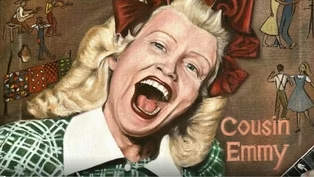
Kentucky’s Old State Capitol
Clip: Season 31 Episode 6 | 3m 7sVideo has Closed Captions
Chip learns more about the origin of Kentucky’s Old State Capitol building.
Chip learns more about the origin of Kentucky’s Old State Capitol building as well as some important events that took place there.
Problems playing video? | Closed Captioning Feedback
Problems playing video? | Closed Captioning Feedback
Kentucky Life is a local public television program presented by KET
You give every Kentuckian the opportunity to explore new ideas and new worlds through KET. Visit the Kentucky Life website.

Kentucky’s Old State Capitol
Clip: Season 31 Episode 6 | 3m 7sVideo has Closed Captions
Chip learns more about the origin of Kentucky’s Old State Capitol building as well as some important events that took place there.
Problems playing video? | Closed Captioning Feedback
How to Watch Kentucky Life
Kentucky Life is available to stream on pbs.org and the free PBS App, available on iPhone, Apple TV, Android TV, Android smartphones, Amazon Fire TV, Amazon Fire Tablet, Roku, Samsung Smart TV, and Vizio.
Providing Support for PBS.org
Learn Moreabout PBS online sponsorship[music playing] We're having a great time here today at the Old State Capitol in Frankfort.
This is Megan Sauter.
She's the Museum Programs Administrator with the Kentucky Historical Society.
Megan, thanks so much for letting us be here today.
Thank you for having me.
So, the origin story of the building, tell us how it all came together.
Yes, so it actually begins with the selection of the site for the Capitol.
You see, in 1792, Kentucky had just become a state and a lot of towns wanted to host the Capitol building, but Frankfort came together with its citizens and this plot of land, as well as building materials and cash, to build the building.
And so, they actually chose a proposal by Gideon Shryock, an architect from Lexington, Kentucky, only 24 years old at the time, because of his Greek Revival architectural style.
And how long was this used?
How long was this actually the seat of democracy?
For nearly 80 years.
So, they moved in in 1830, and the last session was in 1908.
So, beyond the columns here in the front, which are beautiful and easy to see, what are some other significant features of the building?
One of the main significant features is going to be our staircase, and it's called a floating staircase, and it was created by inmates as well as a warden who oversaw it, and they cut the stones almost like puzzle pieces, and the keystone forces it into place.
Now, my favorite feature of the building is actually the cupola, which is a dome, and it lets in so much beautiful natural light upstairs as well as around it.
It has beautiful plaster pendants, and it shows you just the significance and the craftsmanship that went into finishing the building.
And beyond being the seat of Kentucky's democracy during the Civil War, there were a lot of important things that happened in this building.
What are some of the highlights there?
Yeah, so the Kentucky General Assembly actually passed to maintain neutrality between the conflict of the Union and the Confederacy.
However, the Confederate Army actually violated that act, and they overtook the Old State Capitol building, and they inaugurated their Confederate governor inside this building until the Union Army ran them out.
Wow.
So, when was it determined this really isn't meeting our needs, we need to build something?
Yeah, so in 1904, legislation was actually passed to erect a new Capitol building, and that same year, we actually received 1.3 million dollars from a settlement with the federal government due to damages during the Civil War and the Spanish-American War, and so they moved to the new Capitol building in 1910.
Was this just no longer big enough for them?
Did it not meet their needs?
What was the issue?
It was too small, and also it just had a lot of renovations that needed to happen.
Right.
So, why is it important, do you think, Megan, for us to preserve structures like this?
Why do we need to hang on to parts of our history like this?
Yeah, so this is the People's House, which is vital to our history, and learning about our past is very important today.
And with historic features like this, you're able to learn about the stories of the people that worked there and the events that happened that fueled the decisions that were made here.
So, learning about our past informs us for our future.
It's a remarkable piece of history that we've enjoyed getting to explore today, and we're going to check out more a little bit later.
Megan, thanks so much for being with us.
Thank you for having me.
[music playing]
Video has Closed Captions
Clip: S31 Ep6 | 6m 26s | World-renowned glass artist Dale Chihuly has chosen a small Kentucky town for his latest exhibition. (6m 26s)
It's My Life: The Cousin Emmy Story
Video has Closed Captions
Clip: S31 Ep6 | 5m 34s | Born in Barren County, Cynthia Carver created the stage persona of Cousin Emmy and never looked back (5m 34s)
Professional Sports in Kentucky
Video has Closed Captions
Clip: S31 Ep6 | 7m 8s | Sports serve as a significant economic driver for Kentucky. (7m 8s)
Providing Support for PBS.org
Learn Moreabout PBS online sponsorshipSupport for PBS provided by:
Kentucky Life is a local public television program presented by KET
You give every Kentuckian the opportunity to explore new ideas and new worlds through KET. Visit the Kentucky Life website.
















